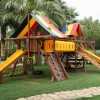 “As much as parents like to think that bullying is something that’s outgrown in childhood, unfortunately it’s actually on the increase in adolescence. There are various individual and school-based approaches to dealing with bullying, but a new intervention that you might find surprising is none other than family therapy. ” This 2-page Family Album Radio transcript was written by Kate Fogarty, and published by the UF Department of Family Youth and Community Sciences, August 2012.
“As much as parents like to think that bullying is something that’s outgrown in childhood, unfortunately it’s actually on the increase in adolescence. There are various individual and school-based approaches to dealing with bullying, but a new intervention that you might find surprising is none other than family therapy. ” This 2-page Family Album Radio transcript was written by Kate Fogarty, and published by the UF Department of Family Youth and Community Sciences, August 2012.
http://edis.ifas.ufl.edu/fm399
Tag: Family Album Radio transcripts
Cyberbullying (FAR1713/FM398)
 “Bullying, or aggression on a continual basis between peers where one has a power advantage over another—is common among children and adolescents. Using intimidation and physical force or spreading rumors is often what comes to mind when we think of bullying. However, a form that parents and teachers may be less aware of is called “cyberbullying.” This involves put-downs, publicly sharing personal information, stalking, and other overt attacks upon a person, all using electronic communication.” This 2-page Family Album Radio transcript was written by Kate Fogarty and published by the UF Department of Family Youth and Community Sciences, August 2012.
“Bullying, or aggression on a continual basis between peers where one has a power advantage over another—is common among children and adolescents. Using intimidation and physical force or spreading rumors is often what comes to mind when we think of bullying. However, a form that parents and teachers may be less aware of is called “cyberbullying.” This involves put-downs, publicly sharing personal information, stalking, and other overt attacks upon a person, all using electronic communication.” This 2-page Family Album Radio transcript was written by Kate Fogarty and published by the UF Department of Family Youth and Community Sciences, August 2012.
http://edis.ifas.ufl.edu/fm398
Parents' Spending on Teens (FAR1209/FM421)
 “In a recent study from Teenage Research Unlimited, researchers reported that teens spent $159 billion in 2005. My own experience raising three teens led me to believe that many of them spent their parents’ money in 2005.” This 2-page Family Album Radio transcript was written by Donna Davis, and published by the UF Department of Family Youth and Community Sciences, July 2012.
“In a recent study from Teenage Research Unlimited, researchers reported that teens spent $159 billion in 2005. My own experience raising three teens led me to believe that many of them spent their parents’ money in 2005.” This 2-page Family Album Radio transcript was written by Donna Davis, and published by the UF Department of Family Youth and Community Sciences, July 2012.
http://edis.ifas.ufl.edu/fm421
Teen Birth Rates Decline (FAR1208/FM420)
 “Parents and others who are concerned about teenagers having babies have reason to celebrate. According to the nonprofit research organization Child Trends, the teenage birth rate for 15-19 year olds is at the lowest point in over 40 years. This drop began in 1991 and has roceeded steadily so that it is now one-third lower than the 1991 peak. The other good news is that it continues to fall.” This 2-page Family Album Radio transcript was written by Suzanna Smith, and published by the UF Department of Family Youth and Community Sciences, July 2012.
“Parents and others who are concerned about teenagers having babies have reason to celebrate. According to the nonprofit research organization Child Trends, the teenage birth rate for 15-19 year olds is at the lowest point in over 40 years. This drop began in 1991 and has roceeded steadily so that it is now one-third lower than the 1991 peak. The other good news is that it continues to fall.” This 2-page Family Album Radio transcript was written by Suzanna Smith, and published by the UF Department of Family Youth and Community Sciences, July 2012.
http://edis.ifas.ufl.edu/fm420
Helping Your Child Adjust to Child Care: Child Care 3 (FAR0309/FM419)
 “Almost 13 million of the 18 million children younger than five years of age in the U.S. are in some form of regular childcare (Overturf Johnson, 2002). This means that millions of parents are finding ways to help their children adjust to being away from Mom or Dad and get used to a new routine and situation. Child development experts recommend a number of strategies, particularly in the early weeks of care.” This 2-page Family Album Radio transcript was written by Suzanna Smith, and published by the UF Department of Family Youth and Community Sciences, July 2012.
“Almost 13 million of the 18 million children younger than five years of age in the U.S. are in some form of regular childcare (Overturf Johnson, 2002). This means that millions of parents are finding ways to help their children adjust to being away from Mom or Dad and get used to a new routine and situation. Child development experts recommend a number of strategies, particularly in the early weeks of care.” This 2-page Family Album Radio transcript was written by Suzanna Smith, and published by the UF Department of Family Youth and Community Sciences, July 2012.
http://edis.ifas.ufl.edu/fm419
Starting Child Care: Child Care 2 (FAR0308/FM418)
 “Many parents have suffered the heart-wrenching moment of dropping their baby at a new child care setting, only to have them cling and cry. If your child is starting child care, you can help make the transition easier by following a few guidelines from child development experts to help you and your child prepare for this change” This 2-page Family Album Radio transcript was written by Suzanna Smith, and published by the UF Department of Family Youth and Community Sciences, July 2012.
“Many parents have suffered the heart-wrenching moment of dropping their baby at a new child care setting, only to have them cling and cry. If your child is starting child care, you can help make the transition easier by following a few guidelines from child development experts to help you and your child prepare for this change” This 2-page Family Album Radio transcript was written by Suzanna Smith, and published by the UF Department of Family Youth and Community Sciences, July 2012.
http://edis.ifas.ufl.edu/fm418
Old Maid No More (FAR3038/FM416)
 “Twenty years ago, women were being warned that, according to demographic research, if they didn’t marry by the time they were in their early twenties, they would likely live out their lives unwed. As a child, I was even told that “those” women became “old maids,” and I feared a similar fate. Fast-forward to 2006, and the news is quite different.” This 2-page Family Album Radio transcript was written by Donna Davis, and published by the UF Department of Family Youth and Community Sciences, July 2012.
“Twenty years ago, women were being warned that, according to demographic research, if they didn’t marry by the time they were in their early twenties, they would likely live out their lives unwed. As a child, I was even told that “those” women became “old maids,” and I feared a similar fate. Fast-forward to 2006, and the news is quite different.” This 2-page Family Album Radio transcript was written by Donna Davis, and published by the UF Department of Family Youth and Community Sciences, July 2012.
http://edis.ifas.ufl.edu/fm416
Playing It Safe with Play Equipment (FAR0086/FM415)
 “Raising my rough-and-tumble children at times took superhuman energy, patience, and constant supervision. Even the joyful vision of a playground could be daunting when the swing was used as a human slingshot and the slide had 101 uses, of which only one was acceptable. I’m sure many parents can relate to the fear of the unknown dangers on the playground.” This 2-page Family Album Radio transcript was written by Donna Davis, and published by the UF Department of Family Youth and Community Sciences, July 2012.
“Raising my rough-and-tumble children at times took superhuman energy, patience, and constant supervision. Even the joyful vision of a playground could be daunting when the swing was used as a human slingshot and the slide had 101 uses, of which only one was acceptable. I’m sure many parents can relate to the fear of the unknown dangers on the playground.” This 2-page Family Album Radio transcript was written by Donna Davis, and published by the UF Department of Family Youth and Community Sciences, July 2012.
http://edis.ifas.ufl.edu/fm415
Sun Protection for Your Children (FAR0084/FM412)
 “My children were all born during the summer months, and as we gradually spent more and more time outside, I wondered how best to protect them from the hot summer sun.” This 2-page Family Album Radio transcript was written by Suzanna Smith, and published by the UF Department of Family Youth and Community Sciences, July 2012.
“My children were all born during the summer months, and as we gradually spent more and more time outside, I wondered how best to protect them from the hot summer sun.” This 2-page Family Album Radio transcript was written by Suzanna Smith, and published by the UF Department of Family Youth and Community Sciences, July 2012.
http://edis.ifas.ufl.edu/fm412
Teen Dating on the Decline (FAR1207/FM409)
 “Ah, the first date! This is coming up soon for some of my teenage friends. Chances are they will be excited—and nervous, too. And it’s no wonder. Child and family experts say that dating is a major change and one of the more challenging adjustments teens face.” This 2-page Family Album Radio transcript was written by Suzanna Smith, and published by the UF Department of Family Youth and Community Sciences, July 2012.
“Ah, the first date! This is coming up soon for some of my teenage friends. Chances are they will be excited—and nervous, too. And it’s no wonder. Child and family experts say that dating is a major change and one of the more challenging adjustments teens face.” This 2-page Family Album Radio transcript was written by Suzanna Smith, and published by the UF Department of Family Youth and Community Sciences, July 2012.
http://edis.ifas.ufl.edu/fm409
Breastfeeding during Disaster (FAR0430/FM429)
 “As we’ve learned over the past couple of years, disaster can strike anyone, anywhere, and anytime. A natural disaster, whether hurricane, tornado, flood, or tsunami, can devastate areas and leave families without resources, sometimes for long periods of time. And while people of all ages suffer, infants can be at far greater risk. However, mothers can save their infants’ lives and protect them from illness by simply breastfeeding, even if they haven’t been breastfeeding their baby.” This 2-page Family Album Radio transcript was written by Donna Davis, and published by the UF Department of Family Youth and Community Sciences, July 2012.
“As we’ve learned over the past couple of years, disaster can strike anyone, anywhere, and anytime. A natural disaster, whether hurricane, tornado, flood, or tsunami, can devastate areas and leave families without resources, sometimes for long periods of time. And while people of all ages suffer, infants can be at far greater risk. However, mothers can save their infants’ lives and protect them from illness by simply breastfeeding, even if they haven’t been breastfeeding their baby.” This 2-page Family Album Radio transcript was written by Donna Davis, and published by the UF Department of Family Youth and Community Sciences, July 2012.
http://edis.ifas.ufl.edu/fm429
Online Sexual Solicitation (FAR1210/FM431)
 “Internet connectivity in the form of blogs, chat rooms, and forums can be hazardous to our teens today. These online communication aids are not themselves the problem; rather, teens face an ever-present threat of being sexually solicited online.” This 2-page Family Album Radio transcript was written by Kate Fogarty, and published by the UF Department of Family Youth and Community Sciences, July 2012.
“Internet connectivity in the form of blogs, chat rooms, and forums can be hazardous to our teens today. These online communication aids are not themselves the problem; rather, teens face an ever-present threat of being sexually solicited online.” This 2-page Family Album Radio transcript was written by Kate Fogarty, and published by the UF Department of Family Youth and Community Sciences, July 2012.
http://edis.ifas.ufl.edu/fm431
Teens and Dating: Tips for Parents (FAR1211/FM438)
 “I’ll never forget the initial shock I felt when my second grader came home from school one day to tell me that one of her friends was “going out” with one of the little boys in her class. “Going out?!” I asked. “What does that mean?” She couldn’t really answer, much to my relief. Many parents might likewise find themselves unprepared when they first learn their elementary and middle schoolers have developed perfectly normal crushes on their classmates.” This 2-page Family Album Radio transcript was written by Kate Fogarty and Donna Davis, and published by the UF Department of Family Youth and Community Sciences, July 2012.
“I’ll never forget the initial shock I felt when my second grader came home from school one day to tell me that one of her friends was “going out” with one of the little boys in her class. “Going out?!” I asked. “What does that mean?” She couldn’t really answer, much to my relief. Many parents might likewise find themselves unprepared when they first learn their elementary and middle schoolers have developed perfectly normal crushes on their classmates.” This 2-page Family Album Radio transcript was written by Kate Fogarty and Donna Davis, and published by the UF Department of Family Youth and Community Sciences, July 2012.
http://edis.ifas.ufl.edu/fm438
Helping Children with Homework (FAR1718/FM445)
 “Although children and their parents often dread homework, it provides an important opportunity for children to practice what they have learned in school, get more in-depth information, apply skills learned more broadly, obtain important learning and organizational skills, and learn how to work independently with self-discipline. Homework can also give parents a sense of what their children are doing in school and how well they are doing. And homework can even enhance parents’ relationships with their children.” This 2-page Family Album Radio transcript was written by Heidi Liss Radunovich, and published by the UF Department of Family Youth and Community Sciences, July 2012.
“Although children and their parents often dread homework, it provides an important opportunity for children to practice what they have learned in school, get more in-depth information, apply skills learned more broadly, obtain important learning and organizational skills, and learn how to work independently with self-discipline. Homework can also give parents a sense of what their children are doing in school and how well they are doing. And homework can even enhance parents’ relationships with their children.” This 2-page Family Album Radio transcript was written by Heidi Liss Radunovich, and published by the UF Department of Family Youth and Community Sciences, July 2012.
http://edis.ifas.ufl.edu/fm445
Nonresident Mothers (FAR0088/FM424)
 “We read and hear stories with some frequency about “deadbeat dads” or those nonresident fathers who fail to make child support payments. The issue has prompted numerous studies and legislative action as well. But have you ever heard of a “deadbeat mom”? Not likely or rarely. This is a growing problem that has remained largely under the radar.” This 2-page Family Album Radio transcript was written by Donna Davis, and published by the UF Department of Family Youth and Community Sciences, July 2012.
“We read and hear stories with some frequency about “deadbeat dads” or those nonresident fathers who fail to make child support payments. The issue has prompted numerous studies and legislative action as well. But have you ever heard of a “deadbeat mom”? Not likely or rarely. This is a growing problem that has remained largely under the radar.” This 2-page Family Album Radio transcript was written by Donna Davis, and published by the UF Department of Family Youth and Community Sciences, July 2012.
http://edis.ifas.ufl.edu/fm424
Talking with Your Child about School (FAR1719/FM446)
 “In a hurried world, keeping up with our children when we’re trying to juggle marriage, jobs, possibly multiple children, and the many other challenges life can throw at us, we can feel overwhelmed at times. However, keeping lines of communication open with your children can be critical to how they handle the challenges they face, especially when they are in school.” This 2-page Family Album Radio transcript was written by Eboni Baugh and Donna Davis, and published by the UF Department of Family Youth and Community Sciences, July 2012.
“In a hurried world, keeping up with our children when we’re trying to juggle marriage, jobs, possibly multiple children, and the many other challenges life can throw at us, we can feel overwhelmed at times. However, keeping lines of communication open with your children can be critical to how they handle the challenges they face, especially when they are in school.” This 2-page Family Album Radio transcript was written by Eboni Baugh and Donna Davis, and published by the UF Department of Family Youth and Community Sciences, July 2012.
http://edis.ifas.ufl.edu/fm446
How Couples Cope with Infertility (FAR3039/FM433)
 “I’ve had many friends who, soon after they were married, were constantly facing questions from friends and relatives about when they were going to start having children. Many people assume this would be the next logical step. However, many couples choose not to have children, and more than four million married men and women in the U.S. have difficulty conceiving or carrying a child to birth.” This 2-page Family Album Radio transcript was written by Donna Davis, and published by the UF Department of Family Youth and Community Sciences, July 2012.
“I’ve had many friends who, soon after they were married, were constantly facing questions from friends and relatives about when they were going to start having children. Many people assume this would be the next logical step. However, many couples choose not to have children, and more than four million married men and women in the U.S. have difficulty conceiving or carrying a child to birth.” This 2-page Family Album Radio transcript was written by Donna Davis, and published by the UF Department of Family Youth and Community Sciences, July 2012.
http://edis.ifas.ufl.edu/fm433
Music Lyrics and Influence on Teen Sex (FAR1213/FM449)
 “As a baby boomer, I was part of the generation that grew up with rock and roll. I recall the first time I heard my mother respond to explicit lyrics my older brother was listening to and thinking what a renegade he was. They weren’t nearly as explicit as the lyrics of today’s music, and while I swore that I’d never become my mother, I now find myself fighting with my children to turn it off! Perhaps mom was not so far off-base after all!” This 2-page Family Album Radio transcript was written by Donna Davis, and published by the UF Department of Family Youth and Community Sciences, July 2012.
“As a baby boomer, I was part of the generation that grew up with rock and roll. I recall the first time I heard my mother respond to explicit lyrics my older brother was listening to and thinking what a renegade he was. They weren’t nearly as explicit as the lyrics of today’s music, and while I swore that I’d never become my mother, I now find myself fighting with my children to turn it off! Perhaps mom was not so far off-base after all!” This 2-page Family Album Radio transcript was written by Donna Davis, and published by the UF Department of Family Youth and Community Sciences, July 2012.
http://edis.ifas.ufl.edu/fm449
Disaster Planning for Caregivers (FAR6018/FM450)
 “News that a hurricane or tornado is on its way can cause anyone to worry. But if you’re responsible for providing care for someone who’s disabled, chances are you face additional concerns. You and the person you care for may not be able to “jump and run” when the tornado sirens are sounded or the hurricane warning is issued. As a caregiver, you should have specific strategies to be prepared for any natural disaster that may come your way.” This 2-page Family Album Radio transcript was written by Carolyn Wilken, and published by the UF Department of Family Youth and Community Sciences, July 2012.
“News that a hurricane or tornado is on its way can cause anyone to worry. But if you’re responsible for providing care for someone who’s disabled, chances are you face additional concerns. You and the person you care for may not be able to “jump and run” when the tornado sirens are sounded or the hurricane warning is issued. As a caregiver, you should have specific strategies to be prepared for any natural disaster that may come your way.” This 2-page Family Album Radio transcript was written by Carolyn Wilken, and published by the UF Department of Family Youth and Community Sciences, July 2012.
http://edis.ifas.ufl.edu/fm450
Involving Youth in the Community Development Process (FAR1214/FM451)
 “As communities face challenges and opportunities to help serve their residents, they’re often faced with a lack of resources, including volunteers. However, many parents are discovering that their children may not only want to volunteer, but many teenagers are required to volunteer if they’re pursuing a future in college.” This 2-page Family Album Radio transcript was written by Rosemary Barnett and Mark Brennan, and published by the UF Department of Family Youth and Community Sciences, July 2012.
“As communities face challenges and opportunities to help serve their residents, they’re often faced with a lack of resources, including volunteers. However, many parents are discovering that their children may not only want to volunteer, but many teenagers are required to volunteer if they’re pursuing a future in college.” This 2-page Family Album Radio transcript was written by Rosemary Barnett and Mark Brennan, and published by the UF Department of Family Youth and Community Sciences, July 2012.
http://edis.ifas.ufl.edu/fm451